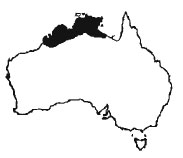Varanus Scalaris
Mertens 1941Banded tree goanna
 |
This goanna is widespread throughout the tropical Northwest of Australia. They can be distinguished from v.timorensis by examination of the tail, which is round in cross section rather than compressed. They reach a maximum size of about 60cm TL. Colour and pattern vary enormously, suggesting that V.secalaris may turn out to be a complex of several species (Mertens 1958; Storr 1980). A race from central Queensland with rusty red stripes over the back (known as "v.pellewensis") is likely to be described as a new species. Specimens from the rainforests of northern Queensland have bright yellow or orange throats (Schmida 1971; Swanson 1976; Green & King 1993). These lizards occur almost wherever there are trees and are said to be absent from some sandstone areas, treeless grasslands and semi-desert
Smith (1927) commented on the climbing ability of this goanna and noted that they would not attempt to bite when captured. According to Shine (1986) V.scalaris is active only during the wet season. Schmida (1971) found 14 specimens in 50m2, all sheltering in hollow branches, and saw them hunting for large insects in trees. Little is known of their diet. Four specimens examined by Losos & Greene (1988) contained a skink, a scorpion and some insects. Schmida (1971) reported that they could also eat small agamids, lizards and birds. He reports that a specimen 20cm TL attacked and swallowed the tail of a gecko almost the same size as itself. Cogger (1973) suggested that they ignored frogs which shared their tree hollows. In captivity both youngsters and adults will hang from branches by their tails (Ruegg 1974).
Some races of V.scalaris can be sexed by looking for spines on either side of the males' vents (Mertens 1958), but according to Schmida (1971) this is not reliable for V.similis. Unlike the Timor monitor, the spotted tree goanna is an aggressive lizard and animals housed together will often fight fiercely. Cannibalism is not unknown. Males are particularly rough with females during courtship and can fatally injure their intended mates. Nevertheless captive breeding is quite possible if adequate space (at least 1m2 of floor area) and plenty of hiding places can be provided (Ruegg 1974; Broer & Horn 1985; Eidenmuller & Wicker 1991). Up to eight eggs are laid which hatch after 115-139 days at 26-30°C into 3.4-5g youngsters. The hatchlings have similar pattern and colouration to the parents. They do well on insects and tiny portions of rodents and will also accept small freshwater fish such as guppies. It may be necessary to raise hatchlings separately. Spoued tree goannas can live for more than 15 years in captivity (Bennett 1994b).
Attribution / Courtesy: Daniel Bennett. 1995. A Little Book of Monitor Lizards. Viper Press U.K.




